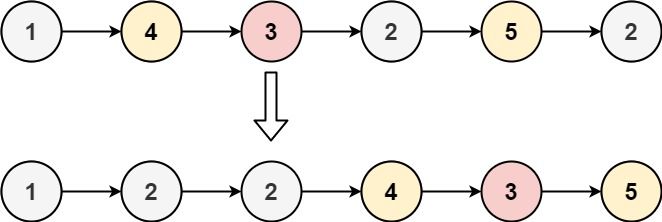C/C++每日一练(20230306)


目录
1. 判断素数的个数 ☆
2. 分隔链表 ★★
1. 判断素数的个数
在一个数组A中存放100个数据,用子函数判断该数组中哪些是素数,并统计该素数的个数,在主函数中输出该素数的个数。
代码:
#include <stdio.h>
#include <stdlib.h>int isPrime(int n)
{int i;if (n < 2)return 0;for (i = 2; i * i <= n; ++i){if (n % i == 0)return 0;}return 1;
}int CountPrime(int a[], int size)
{int i = 0, count = 0;for (i = 0; i < size; i++){if (isPrime(a[i])){printf("%d ", a[i]);count++;if (count % 10 == 0)printf("\\n");}}printf("\\n");return count;
}int main()
{int a[100], i, count = 0;for (i = 0; i < 100; i++)a[i] = rand() % 1000;printf("素数的个数:%d\\n", CountPrime(a, 100));return 0;
}输出:
41 467 281 827 491 827 421 811 673 547
757 37 859 101 439 929 541
素数的个数:17
2. 分隔链表
给你一个链表的头节点 head 和一个特定值 x ,请你对链表进行分隔,使得所有 小于 x 的节点都出现在 大于或等于 x 的节点之前。
你应当 保留 两个分区中每个节点的初始相对位置。
示例 1:

输入:head = [1,4,3,2,5,2], x = 3 输出:[1,2,2,4,3,5]
示例 2:
输入:head = [2,1], x = 2 输出:[1,2]
提示:
- 链表中节点的数目在范围
[0, 200]内 -100 <= Node.val <= 100-200 <= x <= 200
代码:
#include <stdio.h>
#include <stdlib.h>struct ListNode
{int val;struct ListNode *next;
};struct ListNode *partition(struct ListNode *head, int x)
{struct ListNode dummy;struct ListNode *prev1 = &dummy, *pivot;dummy.next = head;for (pivot = head; pivot != NULL; pivot = pivot->next){if (pivot->val >= x){break;}prev1 = pivot;}struct ListNode *p = pivot->next;struct ListNode *prev2 = pivot;while (p != NULL){if (p->val < x){prev2->next = p->next;p->next = prev1->next;prev1->next = p;prev1 = p;p = prev2->next;}else{prev2 = p;p = p->next;}}return dummy.next;
}int main()
{int target = 3;struct ListNode *head = NULL;struct ListNode *prev = NULL;struct ListNode *p;int arr[] = {1,4,3,2,5,2};for (unsigned int i = 0; i < sizeof(arr)/sizeof(int); i++){p = (ListNode*)malloc(sizeof(*p));p->val = arr[i];p->next = NULL;if (head == NULL){head = p;prev = head;}else{prev->next = p;prev = p;}}p = partition(head, target);while (p != NULL){printf("%d ", p->val);p = p->next;}printf("\\n");return 0;
}输出:
1 2 2 4 3 5
比较阅读
单链表的倒转
class Solution {
public:
ListNode* ReverseList(ListNode* head) {
if (head == NULL) return NULL;
ListNode *p = NULL;
ListNode *p1 = head;
ListNode *p2 = p1->next;
while (p2 != NULL) {
p1->next = p;
p = p1;
p1 = p2;
p2 = p2->next;
}
return p;
}
};
3. 数据流的中位数
中位数是有序列表中间的数。如果列表长度是偶数,中位数则是中间两个数的平均值。
例如,
[2,3,4] 的中位数是 3
[2,3] 的中位数是 (2 + 3) / 2 = 2.5
设计一个支持以下两种操作的数据结构:
- void addNum(int num) - 从数据流中添加一个整数到数据结构中。
- double findMedian() - 返回目前所有元素的中位数。
示例:
addNum(1) addNum(2) findMedian() -> 1.5 addNum(3) findMedian() -> 2
进阶:
- 如果数据流中所有整数都在 0 到 100 范围内,你将如何优化你的算法?
- 如果数据流中 99% 的整数都在 0 到 100 范围内,你将如何优化你的算法?
代码:
#include <bits/stdc++.h>
using namespace std;class MedianFinder
{
public:/ initialize your data structure here. */MedianFinder(){}void addNum(int num){auto it = upper_bound(nums.begin(), nums.end(), num);nums.insert(it, num);}double findMedian(){int n = nums.size();if (n % 2 == 0)return 1.0 * (nums[n / 2 - 1] + nums[n / 2]) / 2;elsereturn nums[n / 2];}vector<int> nums;
};/* Your MedianFinder object will be instantiated and called as such:* MedianFinder obj = new MedianFinder();* obj.addNum(num);* double param_2 = obj.findMedian();*/int main(){MedianFinder obj = MedianFinder();obj.addNum(1);obj.addNum(2);double median1 = obj.findMedian();obj.addNum(3);double median2 = obj.findMedian();cout << median1 << endl << median2 << endl;return 0;}输出:
2
1.5
🌟 每日一练刷题专栏
✨ 持续,努力奋斗做强刷题搬运工!
👍 点赞,你的认可是我坚持的动力!
★ 收藏,你的青睐是我努力的方向!
✏️ 评论,你的意见是我进步的财富!
 |
C/C++ 每日一练 专栏 |
 |
Python 每日一练 专栏 |


